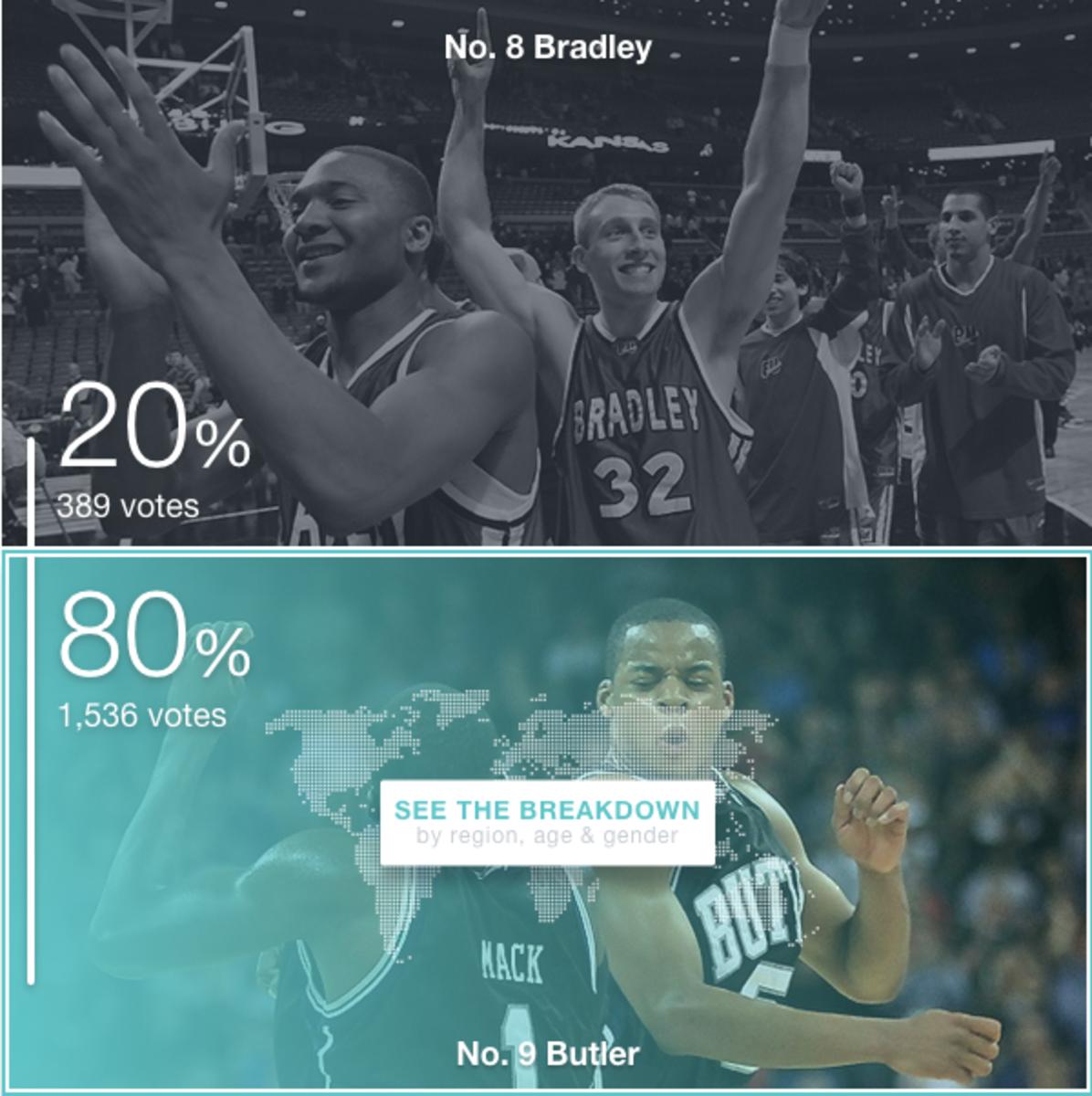Ranking the NCAA tournament's best-ever Cinderellas: The Sweet 16
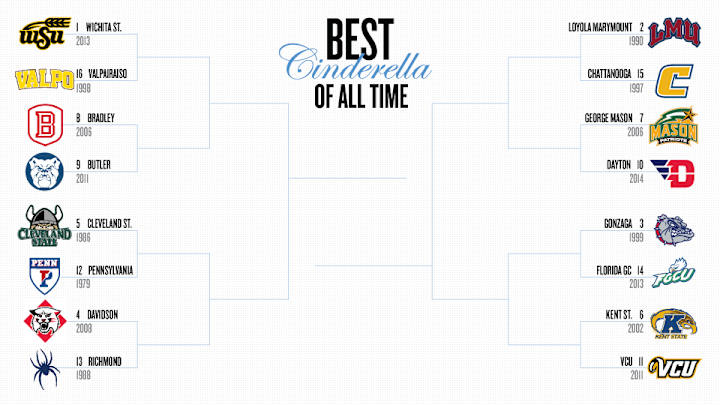
We've whittled the list of best NCAA tournament Cinderellas down to the Sweet 16, and now we want to hear from you. As Alexander Wolff explained in the introductory essay, we took teams only from the traditional seeding era (since 1979) and only those that were seeded ninth or below in their respective year (i.e. in the bottom half of the bracket) and eliminated high-major programs (sorry, 1983 N.C. State and 1985 Villanova), then seeded them in our bracket based on Basketball Reference's Simple Rating System. Below you'll find short stories on all 16 teams. To vote, simply click on the picture of the team you want to advance. Then check back tomorrow to vote again in the Elite Eight. The voting will continue until we are down to a Final Four on Friday and a championship matchup on Monday. The winner will be revealed on Tuesday, Aug. 18.
Editor's note: Voting is now closed for the Sweet 16. Screen shots of the final polls are shown belo. Please proceed to the Elite Eight.
No. 1 Wichita State (2013) vs. No 16 Valparaiso (1998)
Wichita State Shockers
Record: 30-9 (12-6 Missouri Valley Conference)
NCAA tournament result: Entered the tournament as a No. 9 seed in West Regional. Beat No. 8 Pittsburgh, No. 1 Gonzaga, No. 13 La Salle and No. 2 Ohio State. Lost to No. 2 Louisville in the Final Four.
March in August: Ranking the best Cinderellas of the Seeding Era
A year before the aptly named Shockers became the first team in 10 years to enter the NCAA tournament undefeated, they heeded coach Gregg Marshall’s call to “play angry” all the way to the Final Four as a No. 9 seed. That anger translated to a smothering man defense that bludgeoned Pitt in their opening tournament win and helped them grind out an Elite Eight victory over Ohio State, but Wichita State’s signature performance may have come when its defense most had its hands full. Facing top-seeded Gonzaga in the Round of 32, the Shockers opened a 13-point first half lead, only to see the Bulldogs rally and take an eight-point lead with fewer than 12 minutes to play. That’s when Wichita State launched a rally of its own, connecting on five straight threes from four different players to pull back ahead for good.
Those were the 2013 Shockers: timely, balanced, and undaunted. Begoggled forward Carl Hall and point guard Malcolm Armstead were the team’s senior core; freshmen Ron Baker (42.9% from three in the tourney) and Fred VanVleet (25 total points off the bench in the Gonzaga and Ohio State wins) proved burgeoning stars; 6’8” wing Cleanthony Early was all over the place as he led Wichita State in scoring and rebounding. The result was the West region’s top seeds no longer playing, and surely angry. — Dan Greene
Valparaiso Crusaders
Record: 23-10 (13-3 Mid-Continent Conference)
NCAA tournament result: Entered the tournament as a No. 13 seed in the Midwest Regional. Beat No. 4 Mississippi and No. 12 Florida State. Lost to No. 8 Rhode Island in the Sweet 16.
As the final seconds ticked away in Valparaiso’s first-round game against No. 4 seed Mississippi, star guard Bryce Drew rose up for the three-point attempt that would win the game, give his school its first ever NCAA tournament win and make him a hero.
He missed.
This, however, was March, when sometimes you get a second chance at a miracle. After Drew came up short on his attempt with under five seconds to go, Ole Miss’ Ansu Sesay bricked two free throws and, in the scramble for the rebound off the second miss, the ball went out of bounds to the Crusaders with 2.5 seconds to go.
Valpo coach Homer Drew, Bryce’s father, called for “Pacer,” a play the team had practiced every day but had not been able to use in a game. Jamie Sykes—a minor league outfielder in the Diamondbacks system—would throw the ball roughly 70 feet. Bill Jenkins’s job was to catch it and—while still in the air—tap it to Drew, who would be streaking up the sideline ready to catch and shoot.
The play unfolded exactly as it was designed. Drew initially thought his shot was a little short, but it sneaked over the rim and swished through at the buzzer to give the Crusaders a 70-69 win. It has been forever immortalized in school history as The Shot.
There was more drama, if fewer theatrics, in the second round against No. 12 seed Florida State. The game went to overtime but Valpo scratched out an 83-77 win. The smallest school in the NCAA tournament (3,500 students) now had a bandwagon filled with several times that many, and more importantly, a date in the Sweet 16.
It was quite a turnaround for a team that lost its season opener to Bethel (Tenn.), a team that no longer plays Division I. But by the time the Crusaders reached St. Louis for the Midwest Regional semifinals, they had won 13 straight. “It ain’t struck midnight yet,” said sophomore forward Aaron Thompson. It soon would. No. 8 seed Rhode Island, which had stunned Kansas in the second round, upended Valpo, 74-68.
The Crusaders have not won an NCAA tournament game since. Jamie Sykes never reached the major leagues. But every March, Pacer is sure to be a part of every highlight montage: Drew making the shot and falling on the floor. His teammates diving on top of him. He and his father embracing.
It’s a reminder that any school, even one as small as Valparaiso, can win a game in the NCAA tournament. It just needs a chance—or two.
— Ted Keith
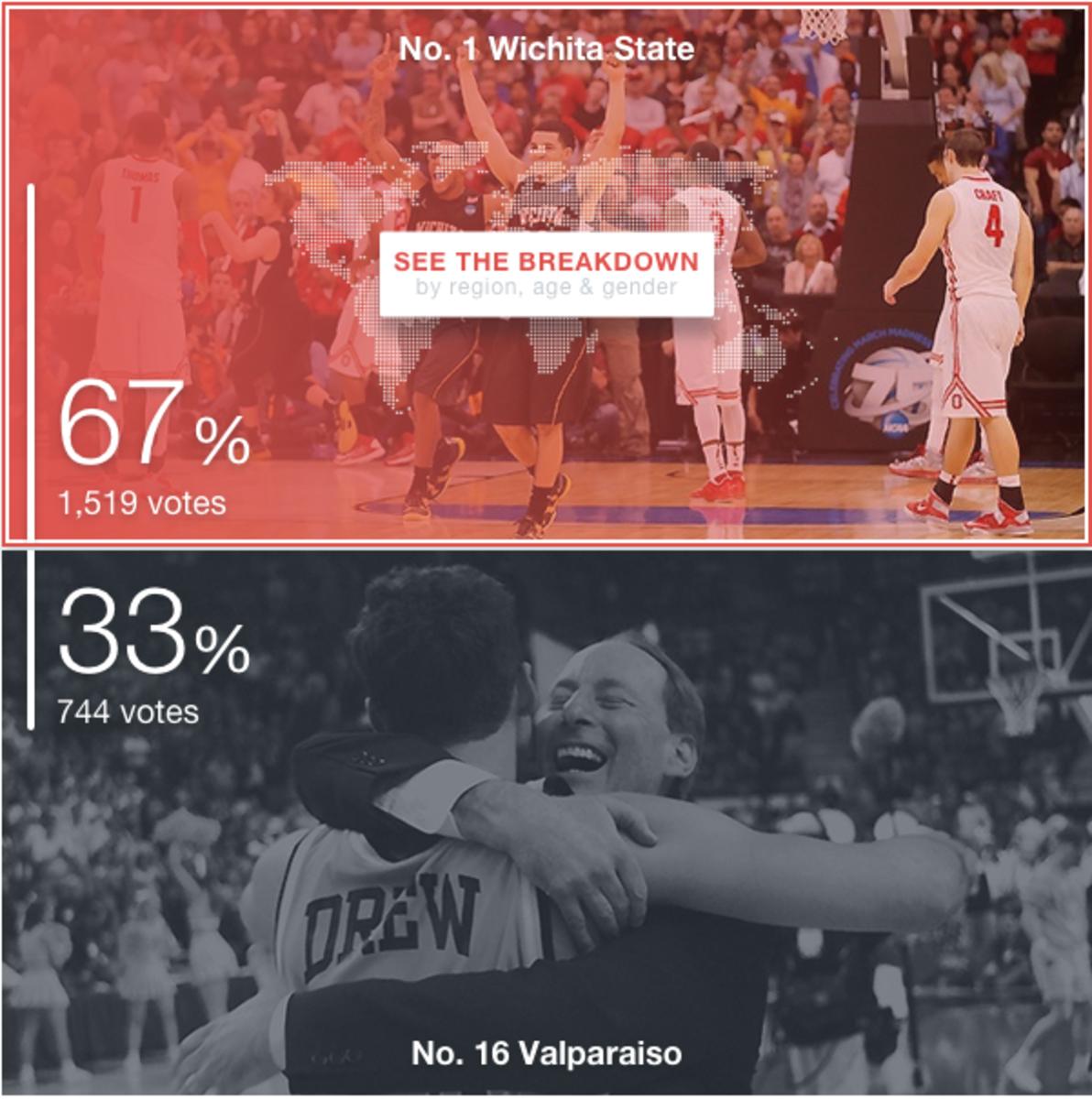
No. 2 Loyola Marymount (1990) vs. No. 15 Chattanooga (1997)
Loyola Marymount Lions
Record: 26-6 (13-1 West Coast Conference)
NCAA tournament result: Entered the tournament as a No. 11 seed in the West Regional. Beat No. 6 New Mexico State, No. 3 Michigan and No. 7 Alabama. Lost to No. 1 UNLV in the Elite Eight.
The Lions may be the No. 2 seed in our bracket, but in the hearts of many college basketball fans, they are the Cinderella team. During the regular season, LMU was marked by a style of play popularized by head coach Paul Westhead that was run-and-gun basketball at its finest. The Lions averaged 122.4 point per game—a record that seems unapproachable in today's college basketball—and cruised to a 13-1 record in the West Coast Conference.
Then, in the second round of conference tournament, tragedy struck. Hank Gathers, who had become just the second player in Division I history to lead the nation in scoring (32.7 ppg) and rebounding (13.7 rpg) in the same season the year prior and who led the nation in scoring again in 1990 (35.3 ppg), collapsed on the court and died of heart failure. Overcome with grief, LMU went further than any team in school history had before or since. Bo Kimble, who transferred to LMU from USC with Gathers and was his best friend, scored 45 points in an opening round 111-92 win over New Mexico State, memorably shooting his first free throw of each game lefthanded in honor of his fallen friend. In the second round, the Lions routed defending champion Michigan 149-115. That's not a typo; they scored nearly 150 points in a postseason game.
Following that win, Kimble and sharpshooter Jeff Fryer appeared on the Arsenio Hall Show and said they would win the national title. LMU advanced from the Sweet 16 with a low-scoring win (62-60) over Alabama but lost to eventual-champion UNLV a step short of the Final Four. Even without the national championship, though, the Lions will be remembered forever as one of the NCAA tournament's most courageous, skilled and beloved teams of all time.
— David Gardner
Chattanooga Mocs
Record: 24-11 (11-3 Southern Conference)
NCAA tournament result: Entered the tournament as a No. 14 seed in the Southeast Regional. Beat No. 3 Georgia and No. 6 Illinois. Lost to No. 10 Providence in the Sweet 16.
The chance of the Mocs making a name for themselves in the 1997 NCAA tournament seemed laughable when the Big Dance began, and not just because the school had only changed its name from Moccasins to Mocs a month before. Yes, they had won the Southern Conference, but they entered the NCAAs as a No. 14 seed, had 10 losses overall—including two to the only “power” schools they’d played, Missouri and Penn State—and in their three previous NCAA trips that decade had lost each time, by an average of 27 points.
Yet Chattanooga had a secret weapon: their breakfast of champions. Once the team arrived at the Southern Conference tournament in Greensboro that March, it began a pregame ritual of eating scrambled eggs, grits, bacon, biscuits and other morning fare no matter what time they were about to play. With that as fuel, the Mocs beat VMI, Davidson and Marshall to earn the league's auto bid, and they stuck with their morning menu when they arrived in Charlotte for the NCAA tournament.
Perhaps inspired by the getting to start their opening round game shortly after noon, Chattanooga feasted on Georgia right from the opening tip, scoring the first 15 points of the game against Tubby Smith’s third-seeded Bulldogs, eventually winning 73-70. If a quick start offensively was the key to their first-round triumph, then it was a late defensive stand that made their second-round victory possible. Against No. 6 seed Illinois, the Mocs surrendered just one basket in the final 10 minutes and outscored the Illini 20-4 in a 75-63 win that earned them the first Sweet 16 bid in school history.
Once in Birmingham, Chattanooga faced another upstart, 10th-seeded Providence, which had beaten second-seeded Duke in the Round of 32 and was led by the unforgettably named guard God Shammgod. The score was tied at 51 with under eight minutes left, but Shammgod helped key a 15-2 run that led the Friars to a 71-65 win. Johnny Taylor, who would be the 17th pick of the NBA draft that June, had 22 points in the loss for Chattanooga. The Mocs have been back to the tournament just twice since 1997, but they’ve been able to dine out on that magical run ever since.
— Ted Keith
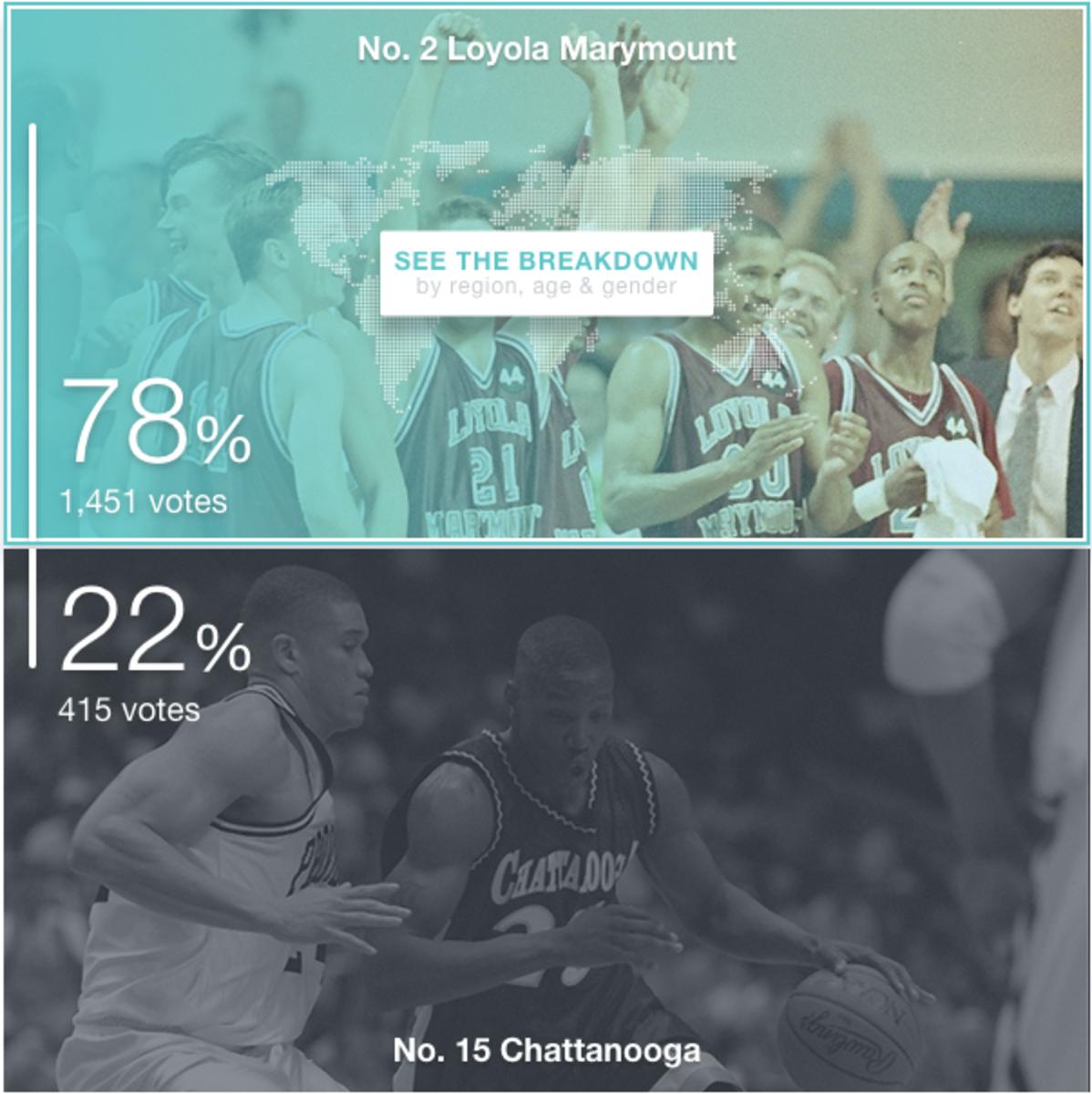
No. 3 Gonzaga (1999) vs. No. 14 Florida Gulf Coast (2013)
Gonzaga Bulldogs
Record: 28-7 (12-2 West Coast Conference)
NCAA tournament result: Entered the tournament as a No. 10 seed in the West Regional. Beat No. 7 Minnesota, No. 2 Stanford and No. 6 Florida. Lost to No. 1 Connecticut in the Elite Eight.
Who wouldn’t want to root for the little Jesuit school nestled in the sleepy town of Spokane, a basketball hotbed that made names like Casey Calvary, Richie Frahm and Matt Santangelo known across the country? With a fiery leader (Santangelo), a sharp shooter (Frahm) and an undersized big man with good timing (Calvary tipped in the winning basket with four seconds remaining in the Sweet 16 win over Florida), the Zags exploded onto the college hoops landscape with a run to the Elite Eight.
The magic began when Frahm went off for 26 points as the Bulldogs shocked seventh-seeded Minnesota 75-63 (the Gophers responded by hiring away GU head coach Dan Monson that spring). Then it was second-seeded Stanford (82-74) and sixth-seeded Florida (73-72). They lost to eventual champion UConn 67-62 in the regional final—a game in which they trailed by one with under one minute to play.
The Bulldogs lived and died by the three, shooting 51% from long-distance (32-of-63) in their three wins, and just 24% in their loss (5-of-21). They were the perfect Cinderella: No one knew where they came from, or how to pronounce their school’s name. Now, of course, they’ve made every NCAA tournament since, and cemented themselves as a powerhouse that will never wear the glass slipper again.
— Lindsay Schnell
Florida Gulf Coast Eagles
Record: 26-11 (13-5 Atlantic Sun)
NCAA tournament result: Entered the tournament as a No. 15 seed in the South Regionals. Beat No. 2 Georgetown and No. 7 San Diego State. Lost to No. 3 Florida in the Sweet 16.
There are a few dark corners of Dunk City that its inhabitants would prefer you ignore. The first is that the party crashers of the 2013 NCAA tournament were less run-and-gun than run-of-the-mill for most of the year. Per kenpom.com, the Eagles ranked 104th in adjusted offensive efficiency and 109th in adjusted defensive efficiency. What’s more, FGCU wasn’t even even an exceptionally great team in transition; its 1.066 points per possession in that scenario ranked in the 60th percentile nationally, per Synergy Sports Data. (The Eagles, in fact, spent almost 80% of their offensive possessions in the half-court.) But coach Andy Enfield’s crew had three individually efficient offensive players. Guards Sherwood Brown and Bernard Thompson and forward Chase Fieler all ranked in the 83rd percentile or better for points per possession overall—Synergy’s “Excellent” range—and collectively they averaged 1.017 points per possession in isolation scenarios.
Essentially, an FGCU that played as it did in the NCAA tournament—and not necessarily as it had for the bulk of the season—would be a threat to nearly anyone. The Eagles were the aggressors and made a living at the line in their first NCAA outing (going 30-for-44 on free throws against Georgetown) and then posted a 112.8 offensive efficiency rating in the next round against San Diego State. In retrospect, the numbers don’t suggest this was a well-kept-secret team all year. But bottle the NCAA tournament formula, and release it on a bracket of Cinderellas? Then FGCU has a trio of double-digit scorers who are adept at making individual plays in the context of a free-flowing offense that is as efficient as it is aggressive.
— Brian Hamilton
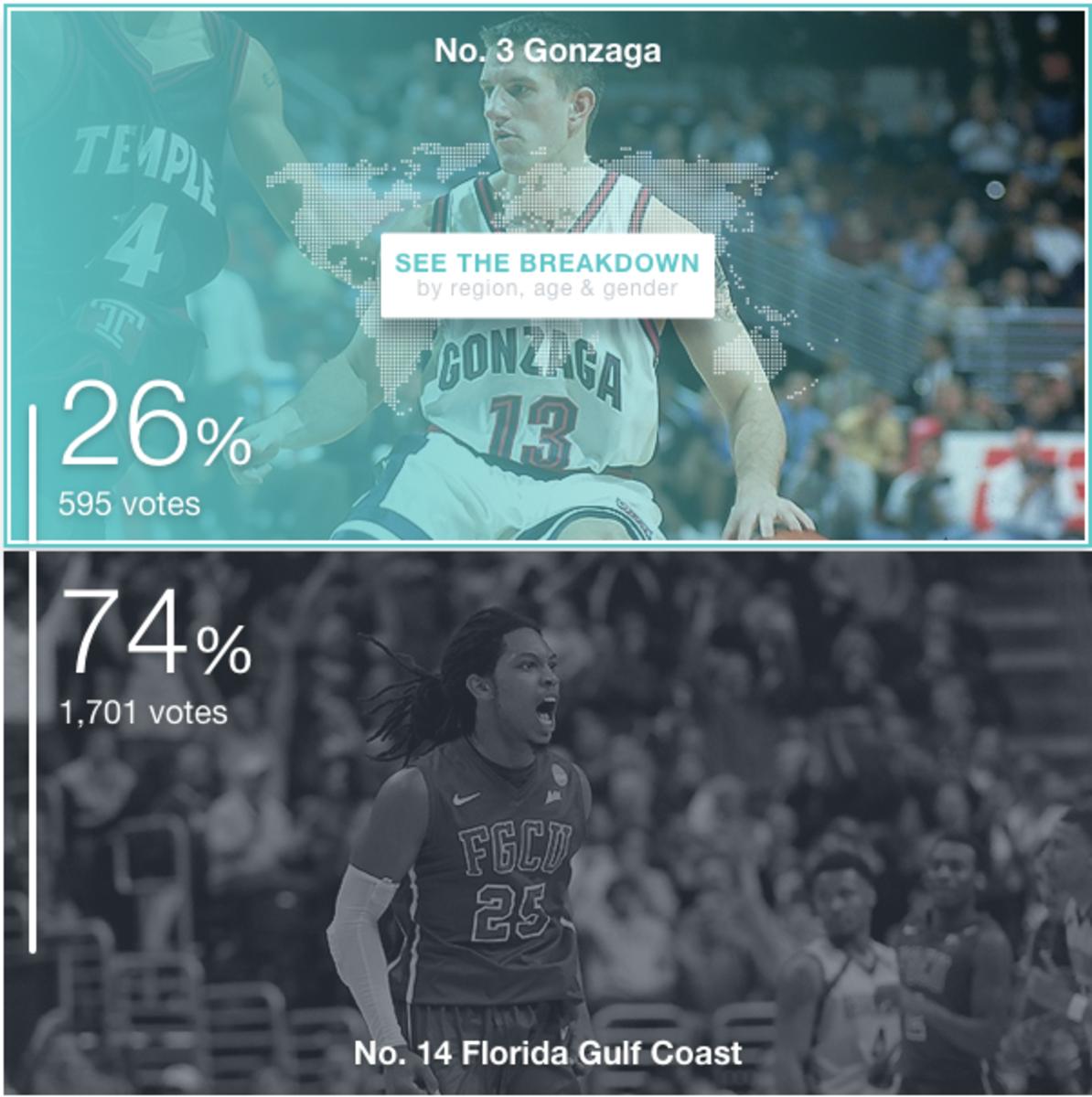
No. 4 Davidson (2008) vs. No. 13 Richmond (1988)
Davidson Wildcats
Record: 29-7 (20-0 Southern Conference)
NCAA tournament result: Entered the tournament as a No. 10 seed in the Midwest Regional. Beat No. 7 Gonzaga, No. 2 Georgetown and No. 3 Wisconsin. Lost to No. 1 Kansas in the Elite Eight.
Why vote for Davidson? It's tempting just to type "Steph Curry" and leave it at that. Before Curry even played a college basketball game, his head coach, Bob McKillop said: "Wait till you see Steph Curry. He is something special." After breaking the school's freshman scoring record in 2007, Curry racked up 30 points in an opening-round NCAA tournament loss to Maryland. When he returned as a sophomore, Curry was ready to take the Wildcats much further.
Behind Curry's conference-best 25.5 points per game, Davidson finished its march through the Southern Conference's regular season and tournament unblemished in 2008. In the NCAAs, Curry scored 40 in a first-round 82-76 win over Gonzaga, 30 in a 74-70 win over Georgetown and even put up 33 against Wisconsin's vaunted pack-line defense. Fellow guard Jason Richards, who averaged 13.3 points per game, was a worthy second fiddle, but this was Steph's show all along and one that even LeBron James had to see in person. In the Elite Eight against top seed Kansas, Curry scored 25 points but made just 4-of-16 from three, and the Jayhawks denied him a chance to get off a game-winning attempt. Kansas survived, 59-57, and went on to win the national championship. Curry returned from his senior season and made first-team All-America before heading to the NBA. Say, whatever happened to that guy?
— David Gardner
Richmond Spiders
Record: 26-7 (11-3 Colonial Athletic Association)
NCAA tournament result: Entered the tournament as a No. 13 seed in the East Regional. Beat No. 4 Indiana and No. 5 Georgia Tech. Lost to No. 1 Temple in the Sweet 16.
Richmond was a consummate giant killer. Coach Dick Tarrant had a knack for offsetting his team’s size and talent disadvantages with superior game planning and savvy tactical tweaks. The most famous example of this took place in March 1991, when Richmond became the first No. 15 seed to upset a No. 2 seed (Syracuse). But the Spiders, hailing from the Colonial Athletic Association, were slaying big boys long before that. As a No. 12 seed in 1984, they upended an Auburn team led by eventual Hall of Famer Charles Barkley and future NBA Rookie of the Year Chuck Person. That helps to explain why, four years later, Richmond was not daunted when it drew defending national champion Indiana in the opening round. Even though the Spiders were ill-equipped physically to grapple with the Hoosiers, they pulled out a three-point victory after a late missed jumper from guard Keith Smart, who one year earlier had hit the shot that won the title against Syracuse.
In the next round, the Spiders got 27 points from undersized power forward Peter Woolfolk in an upset over a Georgia Tech, a No. 5 seed coached by ACC legend Bobby Cremins. A loss to Temple in the Sweet 16 ended Richmond’s run, but it didn’t diminish the Spiders’ status as one of the best Cinderellas ever. Woolfolk was a load inside, guard Ken Atkinson provided a playmaking spark on the perimeter and Richmond confounded opponents by frequently switching defenses. Still, what made the Spiders such a scary team, from the perspective of a high-major power such as Indiana, was Tarrant—a shrewd strategist who routinely outfoxed the coach strutting the opposite sideline (just last month, Richmond named its court after him). Knight and Cremins both learned that the hard way.
— Chris Johnson
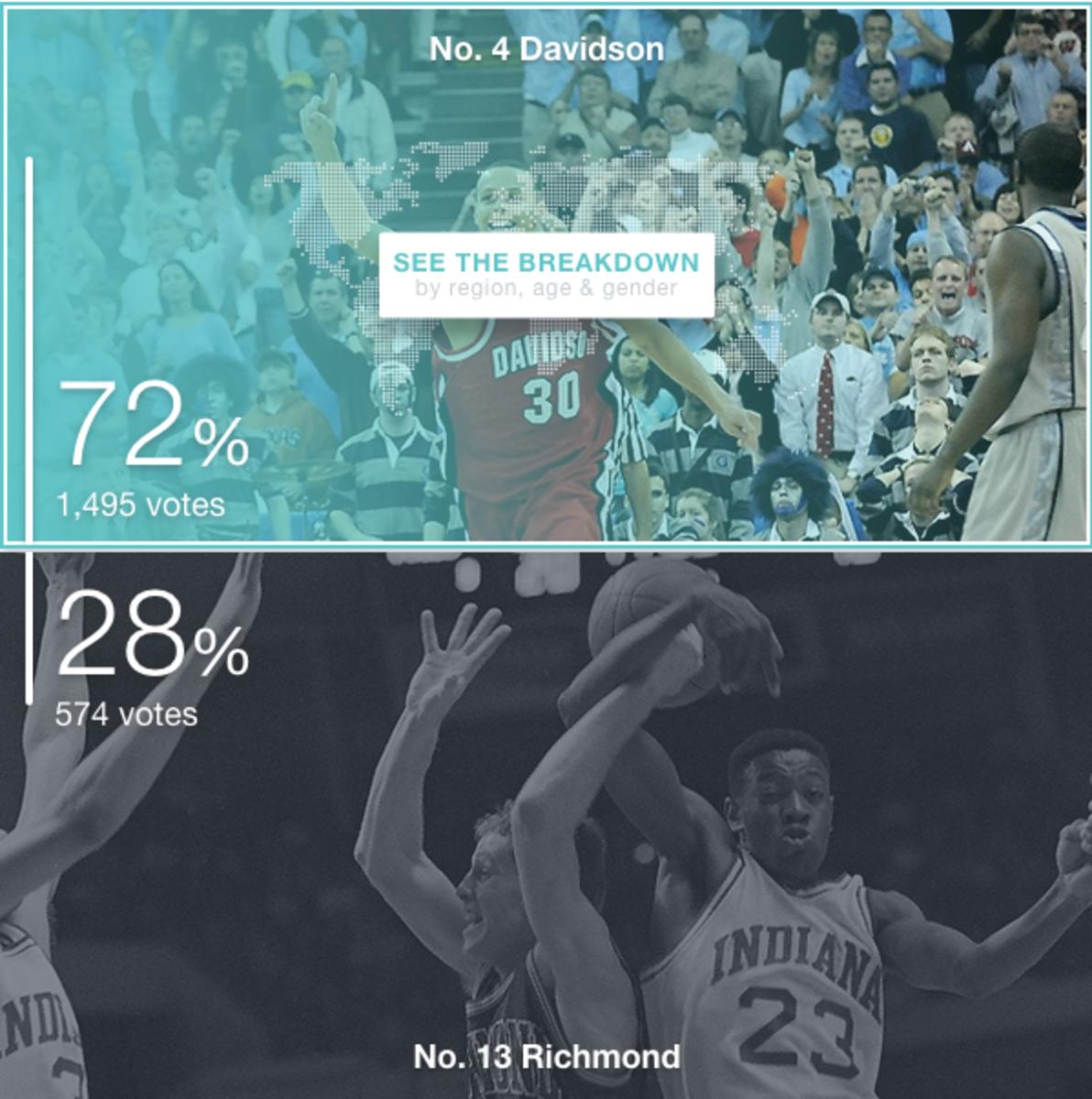
No. 5 Cleveland State (1986) vs. No. 12 Penn (1979)
Cleveland State Vikings
Record: 29-4 (13-1 AMCU-8)
NCAA tournament result: Entered the tournament as a No. 14 seed in the East Regional. Beat No. 3 Indiana and No. 6 St. Joseph's. Lost to No. 7 Navy in the Sweet 16.
The 14th-seeded Vikings’ defeats of No. 3 Indiana and No. 6 St. Joseph’s made for two firsts: the first time a Bob Knight team had ever been bounced from the NCAAs in the first round, and the first time a team seeded so low had advanced so far. It took nine blocks and a last-second score from Navy’s David Robinson to finally eliminate CSU in the regional semifinal, and then only by a point.
The run made an instant star of the Vikes’ floor leader, Ken (Mouse) McFadden, whose sallies into the lane at one point prompted St. Joe’s center Rodney Blake to yell, “Stop that Mouse!” And it led the Hoosiers to curse forward Clinton Ransey, whose 27 points helped ensure their defeat—which in turn led Knight to schedule practices for the rest of the tournament in spite of their elimination.
Forget that coach Kevin Mackey would soon descend into cocaine addiction; with its run, Cleveland State gave the league that sounded like a vaccine, the AMCU-8, a national profile. And the Vikings became further immortalized when UNLV coach Jerry Tarkanian invoked them in one of his anti-NCAA diatribes: “The NCAA is so mad at Kentucky they’ll probably slap another few years’ probation on Cleveland State.”
— Alexander Wolff
Penn Quakers
Record: 25-7 (13-1 Ivy League)
NCAA tournament result: Entered the tournament as a No. 9 seed in the East Regional. Beat No. 8 Iona, No. 1 North Carolina, No. 4 Syracuse and No. 10 St. John's. Lost to No. 2 Michigan State in the Final Four; lost third-place game to No. 2 DePaul.
A newspaper in North Carolina’s Triangle called it “Black Sunday,” so astonishing were the second-round results from Raleigh—No. 9 Penn’s defeat of top-seeded North Carolina within hours of No. 10 St. John’s win over second-seeded Duke at Raleigh's Reynolds Coliseum. But the Quakers were far from finished. A week later, in a Greensboro Coliseum largely empty thanks to the elimination of the local favorites, Tony Price, Bobby Willis, Booney Salters and Co. knocked off Syracuse and St. John’s to land the Ivy League’s first Final Four berth since Bill Bradley and Princeton in 1965.
Under the direction of coach Bob Weinhauer, this Quaker team was the culmination of an astonishing stretch going back a decade for the school, one that produced such stars as Bob Morse, Corky Calhoun, Craig Littlepage, Phil Hankinson and Keven McDonald. Magic Johnson and Michigan State would end Penn’s dream in the thin air of Salt Lake City, 101-67. But the Quakers proved that their run was no fluke two days later, when they nearly outshot and outran Mark Aguirre’s DePaul Blue Demons in the third-place game before losing 96-93. All in all, it was a performance that put to shame another North Carolina newspaper, one in Greensboro that referred to the East Regional champs as “Penn State.”
— Alexander Wolff
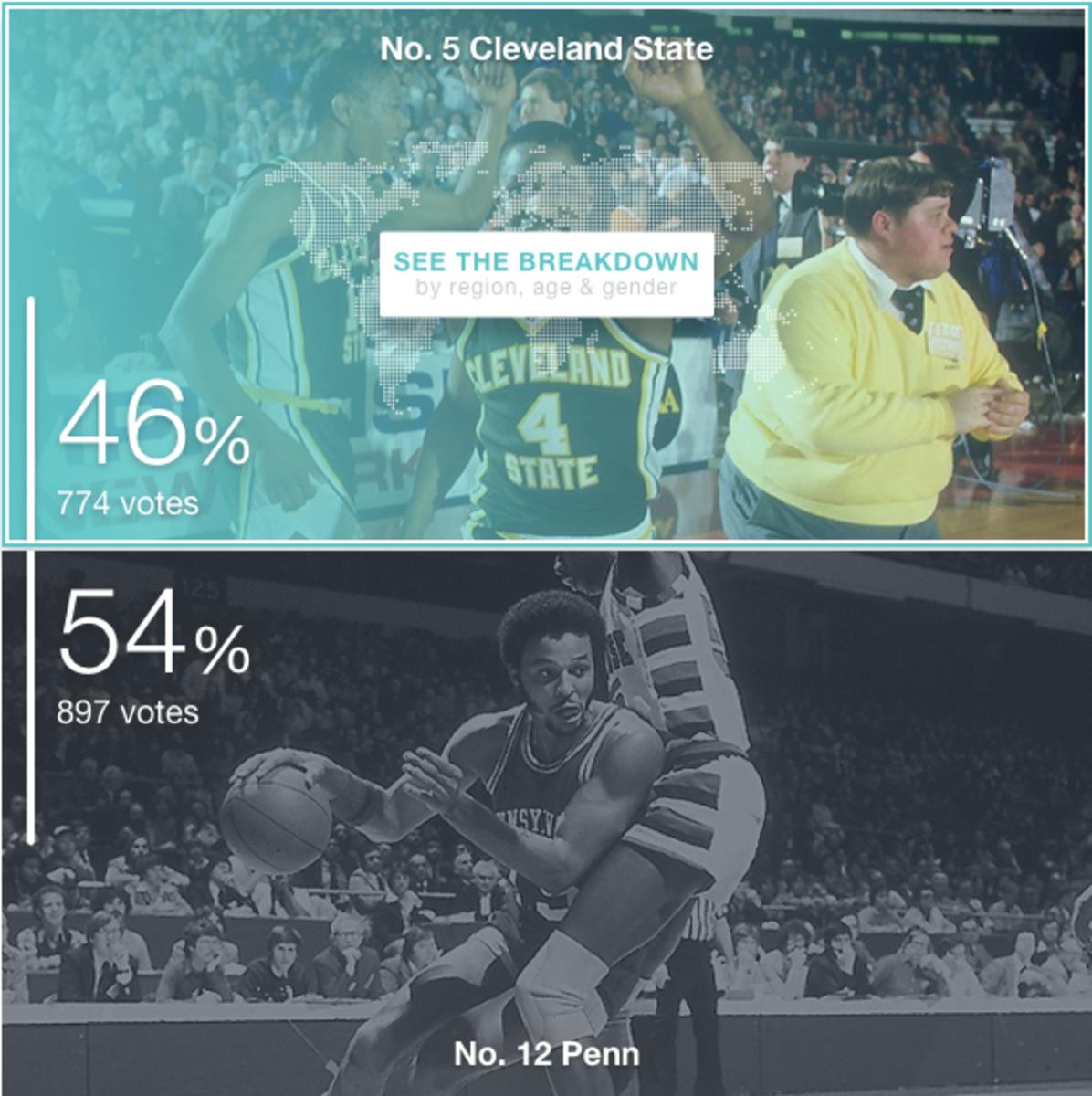
No. 6 Kent State (2002) vs. No. 11 VCU (2011)
Kent State Golden Flashes
Record: 30-6 (17-1 Mid-American Conference)
NCAA tournament result: Entered the tournament as a No. 10 seed in the South Regional. Beat No. 7 Oklahoma State, No. 2 Alabama and No. 2 Pittsburgh. Lost to No. 5 Indiana in the Elite Eight.
Stan Heath knew what it took to win in the NCAAs. Prior to taking over as Kent State’s head coach in April 2001, he had served as an assistant at Michigan State for five seasons, helping the Spartans reach three Final Fours and win the national championship in 2000. But the task Heath took on with the Golden Flashes was essentially the opposite of the one he had at Michigan State. Instead of helping a No. 1 seed stave off plucky mid-majors and other high seeds while advancing through the bracket, Heath was devising ways for his team, from the Mid American Conference, to spring upsets against high-major juggernauts like the Spartans. Kent State entered the 2002 tournament hotter than perhaps any other squad in the field. It had not lost since Jan. 9, and it won each of its three MAC tournament games by at least 11 points.
Mind you, that streak was not merely a product of weak competition. The Flashes were a senior-laden team that wielded the MAC’s most efficient offense during conference play and ranked eighth in the nation in defensive efficiency, according to kenpom.com. They got reliable perimeter scoring from guards Trevor Huffman and Andrew Mitchell and also featured a JUCO transfer power forward named Antonio Gates, who would later realize that his future lay in a different sport. To open the tournament, Kent State cruised past No. 7 seed Oklahoma State, then handled No. 2 seed Alabama and edged No. 3 seed Pittsburgh. In the regional final, Kent State drew Indiana, which had knocked out top-seeded Duke in the Sweet 16. Alas, the Hoosiers, the eventual national runners-up, were one of the few teams in the country with a better defense than that of the Golden Flashes, and when Indiana also made 15 of 19 three-pointers, Kent State's season ended with an 81-69 loss.
— Chris Johnson
VCU Rams
Record: 28-11 (12-6 Colonial Athletic Association)
NCAA tournament result: Entered the NCAA tournament in the "First Four" as a No. 11 seed in the Southwest Regional. Beat No. 11 Southern California, No. 6 Georgetown, No. 3 Purdue, No. 10 Florida State and No. 1 Kansas. Lost to No. 8 Butler in the Final Four.
Long before Lil B became a mainstream basketball topic by putting hexes on Kevin Durant (in 2014) and James Harden (in 2015), the rapper was on the VCU bandwagon. The 2011 NCAA tournament was a time when a team could borrow Lil B's signature phrase, "swag," as a call-and-response thing during 33-year-old coach Shaka Smart's postgame speeches and Lil B's cooking dance, as a locker-room celebration, and get a Twitter shout-out rather than a curse. VCU seemed to have some powerful magic on its side, given that it had finished fourth in the CAA and was the NCAAs' worst at-large selection, by far, according to kenpom.com's rankings, where the Rams were 84th at the end of the regular season. Efficiency-based projections gave them a 0.03% chance of reaching the final weekend, yet they did just that, becoming arguably the most improbable Final Four team ever.
How did No. 11-seeded VCU roll through USC (in the First Four), Georgetown, Purdue, Florida State and Kansas, before eventually falling to Butler in Houston? It was a case of a loose, experienced team finding its groove on offense and defending out of its mind. The Rams had swag on their side, a lineup with four senior starters, including heady point guard Joey Rodriguez and versatile forward Jamie Skeen, and they were on such a hot streak that they shot 12-of-25 from deep against the Hoyas (in the round of 64) and the Jayhawks (in the Elite Eight). VCU's D, which Smart called half-havoc, since he had yet to implement his total pressure system, was still a major problem for No. 1-seeded Kansas and its five future NBA players, who were held to just 0.86 points per possession. The Rams weren't great all season, and at times they were downright mediocre, but for three weeks in March, they were cooking with fire.
— Luke Winn
WINNER: Kent State over VCU
No. 7 George Mason (2006) vs. No. 10 Dayton (2014)
George Mason Patriots
Record: 27-8 (15-3 Colonial Athletic Association)
NCAA tournament result: Entered the tournament as a No. 11 seed in the Midwest Regional. Beat No. 6 Michigan State, No. 3 North Carolina, No. 7 Wichita State and No. 1 Connecticut. Lost to No. 3 Florida in the Final Four.
The Patriots of 2006 were old, egalitarian and played asphyxiating defense. A brew of experience and tenacity like that is enough to grind down any foe—and the ability to get stops is particularly useful as a failsafe against bad offense. But George Mason actually wasn’t bad on that end either; it ranked 58th nationally in offensive efficiency, and its raw shooting percentage (48.1%) was good for 15th in the country. Five players averaged 11 points or more, and even though Jim Larranaga’s crew didn’t go much deeper than that, four of the top five scorers shot better than 45% from the floor.
Size was a concern, as none of the rotation players stood taller than 6’7”. But the two nominal big men, Jai Lewis and Will Thomas, were efficient enough rebounders, averaging 7.8 and 7.2 boards per game, respectively. And in this imaginary event, one guesses the lack of height wouldn’t be fatal; other Cinderellas are unlikely to deploy one 7-footer after another. Ultimately, defense was the Patriots' calling card. They ranked 10th in efficiency on that end and opponents managed just a 38.8% effective field goal percentage. George Mason’s reliability in all areas was simply top-notch. There was essentially no weak spot. Everyone was a threat. There are few better recipes for emerging as the belle of the Cinderella ball.
— Brian Hamilton
Dayton Flyers
Record: 26-11 (10-6 Atlantic 10)
NCAA tournament result: Entered the tournament as a No. 11 seed in the South Regional. Beat No. 6 Ohio State, No. 3 Syracuse and No. 10 Stanford. Lost to No. 1 Florida in the Elite Eight.
Like any true Cinderella, there was a time of legitimate doubt as to whether the Flyers would be asked to the Dance at all. Their non-conference schedule contained two bad losses—to Illinois State and Pac-12 bottom-feeder USC—and their A-10 slate started even worse, with five losses in their first six league games. But beginning in February, Dayton was reborn, winning 10 of 12 to close the season and earn one of the final at-large bids.
Its invitation was not exactly inviting: first a game against local bullies Ohio State, and then a potential matchup with Syracuse in upstate New York, where Orange fans turned Buffalo’s First Niagara Center into Carrier Dome West. The Flyers embraced the deck-stacking, declaring themselves “no one’s little brother” before knocking off Ohio State thanks to Vee Sanford’s late floater over Aaron Craft, then ground out a plodding nailbiter against Syracuse’s vaunted 2-3 zone defense. The key was an inspired defense that made its in-season mediocrity (71st nationally in efficiency, 9th in the 14-team A-10) a distant memory, its relentlessness fueled by the depth of Miller’s 12-man rotation. And on offense, whether it was Sanford’s dagger, forward Dyshawn Pierre’s cold-blooded, final-minute free throws against Syracuse, or Jordan Sibert’s quartet of threes in a Sweet 16 win over Stanford, the Flyers just kept coming as well.
— Dan Greene
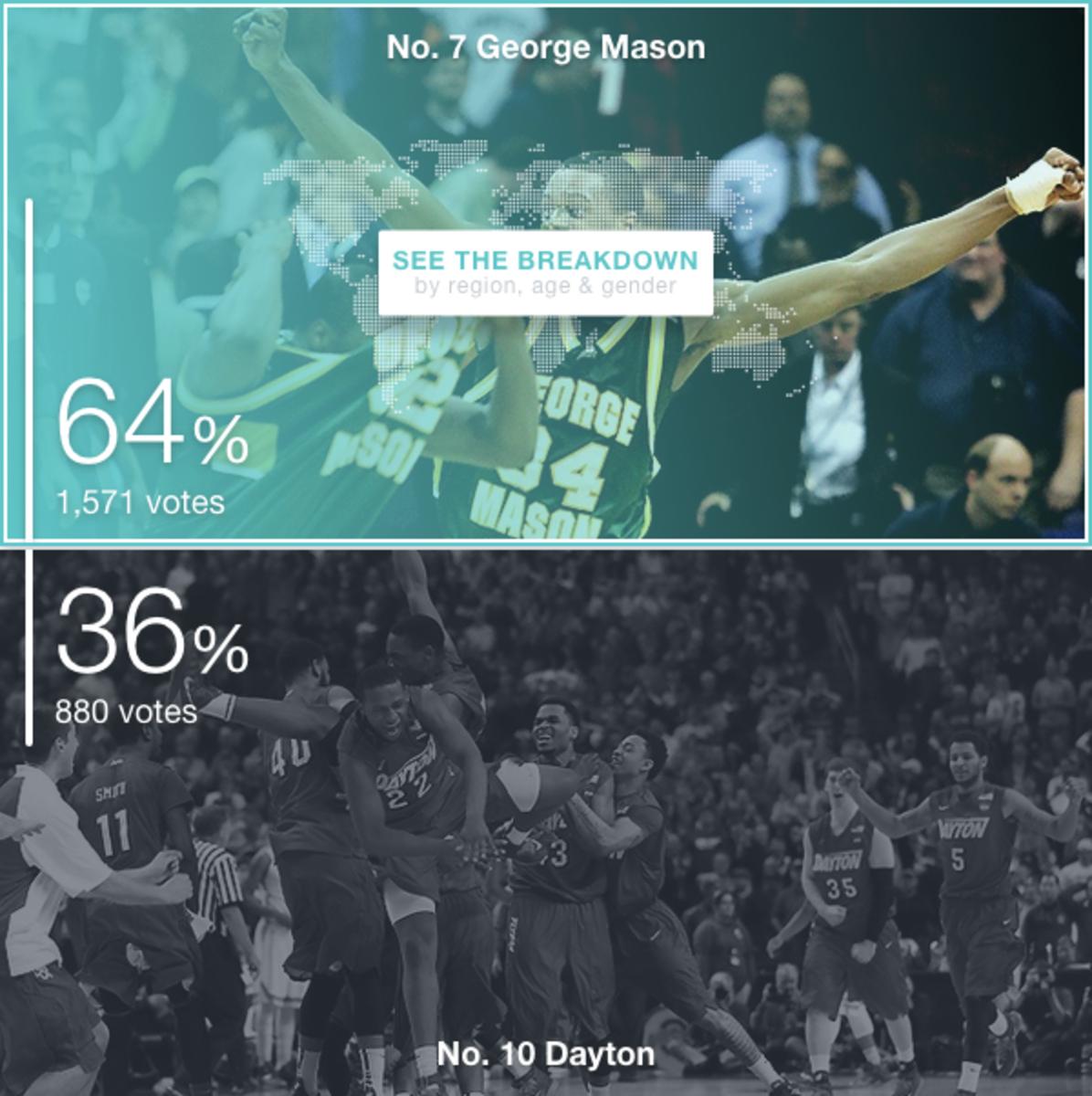
No. 8 Bradley (2006) vs. No. 9 Butler (2011)
Bradley Braves
Record: 22-11 (11-7 Missouri Valley Conference)
NCAA tournament result: Entered the tournament as a No. 13 seed in the Oakland Regional. Beat No. 4 Kansas and No. 5 Pittsburgh. Lost to No. 1 Memphis in the Sweet 16.
In a tournament dominated by Cinderella (George Mason is our No. 7 seed in this contest), the Braves’ tourney run was made sweeter by the fact that their coach, Jim Les, played point guard for the small Peoria, Ill., school from 1983-86. Twenty years later, he led them to the Sweet 16.
A member of the mid-major juggernaut Missouri Valley Conference—the MVC received four bids in 2006, the same number as the ACC, Big 12 and Pac-10—Bradley opened the tournament by sending Kansas home with a first-round loss for the second consecutive year. The Braves drained 11 threes and, after controlling pace most the way, hung on for a 77-73 win. They were mostly subdued in the postgame locker room, acting as if they belonged. But when they stunned fifth-seeded Pitt 72-66 behind 28 points and seven rebounds from 7-foot center Patrick O’Bryant, the scene was more electric. Their celebration made sense when you realized Bradley started the season 2-4 and finished sixth in the MVC regular season. The Braves had rallied to win seven of their last eight and snatch an at-large bid. After beating the Panthers, they partied like it was 1955, the last time the school had gone as deep as the third round. That year, Bradley lost to Colorado. In the 2006 Sweet 16, it fell to Memphis, 80-64. — Lindsay Schnell
Butler Bulldogs
Record: 28-10 (13-5 Horizon League)
NCAA tournament result: Entered the tournament as a No. 8 seed in the Southeast Regional. Beat No. 9 Old Dominion, No. 1 Pittsburgh, No. 4 Wisconsin, No. 2 Florida and No. 11 VCU. Lost to No. 3 Connecticut in the national championship game.
The first of Butler's back-to-back runs to the national title game, in 2010, was a fairytale in every way but the ending. Local mid-major with local, overlooked recruits and a stingy-as-hell defense makes the Indianapolis Final Four, comes within a few inches of a half-court heave of beating Duke. The Bulldogs' second run was more surprising than the first; it was unscripted and chaotic, a series of inexplicable saves on the road to an ugly final against UConn.
Butler was 14-9 in early February, with no case for an at-large NCAA bid and looking like a longshot to win the Horizon League tourney, and things still worked out. It was taken to the brink by Old Dominion and Pittsburgh in the NCAA tournament's first two rounds, winning the former game on a Matt Howard tip-in at the buzzer, and the latter despite Shelvin Mack's foul while up one with 1.4 seconds left—a gaffe topped only by the foul Pitt's Nasir Robinson committed on a missed free throw just before the buzzer, sending Howard to the line for another game-winner. In the Elite Eight, the Bulldogs' solution to breaking down Florida's 2-3 zone was to bring a freshman guard (Chrishawn Hopkins) off the bench who'd been DNP'd in 14 of its previous 17 games—and watch as he sparked a comeback and an overtime win. The 2011 version of Butler had Brad Stevens, the sport's brightest young coach; Mack, a future NBA guard, running their offense; and Howard, a scrapper-forward and future Euro pro, delivering a monster senior season; but their true strength was in finding unfathomable ways to survive. They were the Cardiac Cinderella.
— Luke Winn
